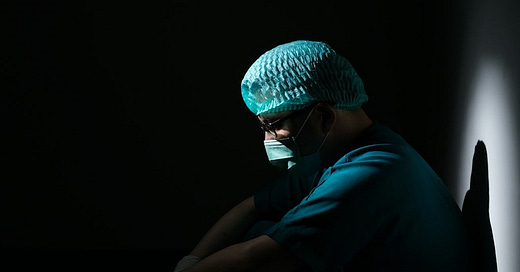I’m sure these statistics have been in one or another of my posts at some point:
-The professions with the highest rate of suicide in the US are medicine and dentistry.
-Somewhere between 300 and 400 physicians in the US die by suicide each year—essentially the equivalent of two full medical school classes.
-More than 50% of US physicians know at least one colleague who has considered, attempted, or died by suicide
Today has been designated Physician Suicide Awareness Day, and I want to do my part to both raise awareness and remind doctors, their loved ones, and patients (who are at risk of losing their doctors) to take action.
At entry to medical school, medical students are not more likely to be depressed than other people of the same age. Yet medical students, resident physicians, and attending physicians all live with a high risk of depression and suicide compared with the general population.
Why? There are many potential contributors. From the beginning of medical school on, the workload is high, and stress is common. The stress of learning and integrating massive amounts of information soon morphs to the stress of long hours and huge responsibilities, often accompanied by sleep deprivation and poor work-life balance during residency. By the time physicians finish training, they have also experienced quite a bit of secondary trauma, as they are repeatedly exposed to suffering and death. Most have made inadvertent errors, which may lead to feelings of guilt and inadequacy. And one in three physicians will be sued for malpractice at some point in their career, with the risk of lawsuit increasing with age and years of practice; regardless of actual liability, lawsuits are associated with stress and depression in physicians. This is far from a complete accounting of reasons, but I think it gives an overview.
Most medical professionals agree that, despite awareness of stress, burnout, and depression during medical training and practice, there is still, in 2024, stigma around mental health issues within medical culture. This leads doctors and medical students to try to ‘tough it out’, to deny the need for help, or to feel unable to reach out for help even when they are aware of needing it. In addition, it is often difficult to find the time to seek treatment, and finding a mental health provider can be challenging these days, even for medical professionals.
UNTREATED (or undertreated) DEPRESSION MAY LEAD TO SUICIDE.
I don’t want to give the impression that no progress has been made. Many medical institutions are trying to break the stigma and make mental health care more accessible. Emotional supports for trainees and stress reduction programs are now common. But cultural shift is slow—the epidemic of physician suicide is unlikely to abate anytime soon.
If you are a medical student, resident, or practicing physician, you can help to break the stigma: check in with your friends and colleagues. If you are a partner or close friend of a med student or doctor, you can be aware of the risk and provide support. Be willing to talk about your own struggles in order to allow others to speak of theirs. If you notice behavioral changes— irritability, isolating, tearfulness, anger— these may all be signs of depression or burnout. Encourage that person to get help (before they get labeled as a ‘disruptive physician’ and encounter punitive or ‘corrective’ action, which is likely to exacerbate the existing depression).
Suicide prevention hotline: call or text 988
NAMI (National Alliance on Mental Illness) helpline (nonemergency): 1-800-950-6264





When talented professionals think they might not be able to live up to their own cherished ideals and expectations, they may contemplate suicide. Here is a story of a physician who broke down under the strain of her work, and thankfully restructured her career in a way that allowed her to keep on living:
https://bairdbrightman.substack.com/p/mental-exhaustion-is-a-danger-to
Heartbreaking, frightening. I had no idea.